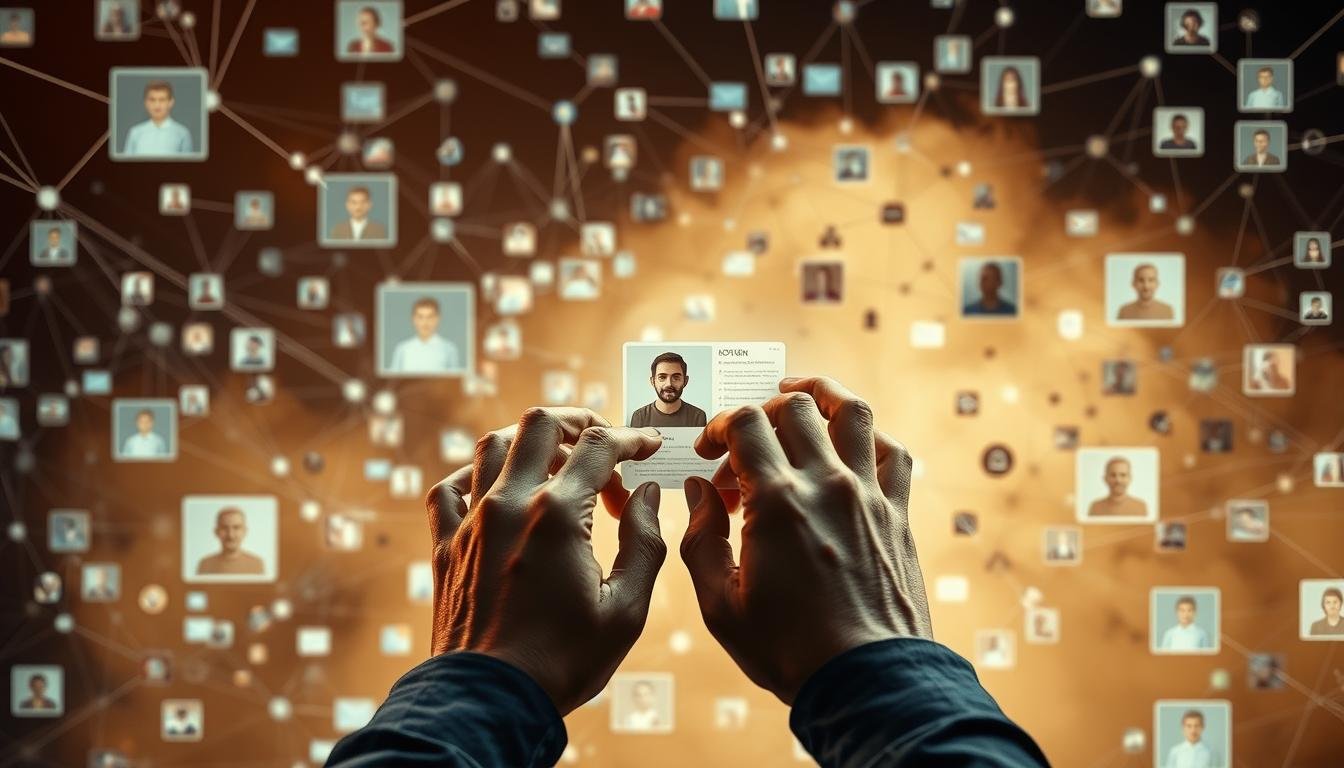Social Catfish – Your Tool to Verify Identities Online!

In our digital world, connections feel real, like a handshake. But dangers hide beneath the surface. You might feel excited online, only to feel uneasy when something seems wrong. Check it out here:
Trust is key in any relationship, especially online. The Federal Trade Commission says Americans lost over $8.8 billion to scams in 2022. This shows how important it is to check identities online. Social Catfish helps you feel safe online by verifying identities.
Key Takeaways
- Social Catfish processes millions of reports to aid in verifying identities online.
- The service helps locate lost connections and verify information.
- In 2022, Americans lost over $8.8 billion to online scams, emphasizing the need for identity verification.
- Tools like the Social Media Finder allow users to uncover fake identities easily.
- Recognizing red flags can help protect against potential scams.
- Oversharing personal information increases vulnerability to scams.
The Importance of Identity Verification Online
In today’s digital world, checking identities online is key to staying safe. As online dangers rise, knowing how to verify identities helps shield you from scams and fraud. This is especially true for platforms used for social networking and dating.
Understanding Online Risks
Online dangers come in many forms, with criminals using clever tricks to steal personal info. They often hide behind anonymity to scam people, causing big financial and emotional losses. As more people go online, scammers find new ways to trick us, making it crucial to verify identities online.
Scams and Fraud in the Digital Landscape
The internet is full of scams targeting users. In the first half of 2020, people lost over $117 million to social media scams. Romance scams also cost a lot, with $201 million lost in 2019, according to the FBI. It’s clear that verifying identities online is a must to avoid these dangers.
Establishing Trust in Online Interactions
Building trust online is vital for safe browsing. By thoroughly checking identities, you protect yourself and feel more secure online. Knowing you can verify identities helps you avoid threats. Using advanced checks and document verification makes the internet safer for everyone.
What is Social Catfish?

Social Catfish is a platform that helps you check identities online. It was started by David McClellan in Murrieta, California. It has grown from a blog about online scams to a tool for investigations. It’s recognized by Reuters and USA Today for its services to keep online interactions safe.
Overview of Services Offered
Social Catfish offers background checks, reverse image searches, and checks on social media profiles. It uses advanced tools to verify identities online. This helps users avoid scams and fake accounts.
How Social Catfish Helps Users
Social Catfish helps you fight online scams. It’s useful for checking someone you met online or finding an old friend. Its algorithms and data analysis are key in these investigations.
It provides detailed reports on background checks and social media activities. The service is easy to use and comes with educational resources. Its reverse image search feature scans millions of profiles to protect your safety.
Using Reverse Search Tools for Verification
In today’s online world, using reverse search tools is key for checking identities. These tools help you make sure online profiles are real, especially when images are involved. There are many types of reverse searches, each designed for different needs.
Types of Reverse Searches Available
Platforms like Social Catfish, Google, and TinEye offer reverse searches. Each tool has special features to help you find the truth. Here are some main types:
- Reverse image search: This method checks where an image comes from, helping you see if a profile picture is real or not.
- Email lookup: It shows if an email is linked to any online identity.
- Username search: It finds where a username has been used online.
Benefits of Reverse Image Searches
Reverse image searches have many benefits in catching fake profiles. They help track where photos in online profiles come from. Tools like Google Lens and Bing Visual Search use advanced tech to identify objects, which is very helpful in checking online profiles.
TinEye, with over 63 billion images in its database, helps find unauthorized image use and plagiarism. Sites like Berify and Pixsy go further by offering legal help for copyright issues and watching image use. These tools not only reveal fake profiles but also make online interactions safer and more trustworthy.
Identifying Catfish: Red Flags to Watch For

It’s key to spot catfishers to stay safe online. Knowing the signs of catfishing helps you move safely through the digital world. Look out for these common catfish scam signs that show someone might be hiding the truth.
Common Signs of Catfish Scams
- Inconsistent or unrealistic profile information, like a job that doesn’t match their online life.
- Reluctance to engage in video calls or meet in person, often with excuses.
- A few social media followers, hinting at a fake identity.
- Photos that are stolen or manipulated, often from famous people.
- Unrealistic stories or claims, like being in far-off places but avoiding meetings.
Incomplete Profiles and Vague Information
Profiles with little info are a warning sign. Catfishers often have detailed photos but few connections. This lack of social media activity might mean something’s off. Watch for:
- Rapid declarations of love or too much affection.
- Vague or evasive answers when asked for personal details.
- Mysterious or overly dramatic life stories that seem made up.
Inconsistencies Across Multiple Platforms
Another big sign of catfishing is when someone presents themselves differently online. Be careful if you notice:
- Profiles with mismatched names, photos, or backgrounds that confuse you.
- Inconsistent image metadata, like different dates or places.
- Pressuring for personal info or money after just talking for a bit.
Catfish Detection Algorithm: How It Works

The catfish detection algorithm is key in verifying identities. It uses advanced tech like AI and machine learning. These tools help analyze big datasets to spot fake identities.
This tech makes identity checks more accurate and quick. It’s a big help in keeping online interactions safe.
Understanding the Technology Behind Detection
Social Catfish uses facial recognition to find matches online. It looks at eye distance, nose shape, and jawline structure. Users just upload a face photo and crop it.
Then, the search engine checks millions of profiles and accounts. It finds possible matches quickly.
Impact of AI and Machine Learning on Verification
This tech makes verifying identities easier and gives detailed results. It finds social media profiles, public records, and images online. It uses public databases, dating sites, and social media to search.
Before paying, users see how many possible matches there are. This makes the process clear and fair.
| Feature | Description |
|---|---|
| Facial Recognition | Analyzes unique facial features for identification. |
| Data Sources | Scans millions of profiles, databases, and social media accounts. |
| Match Results | Provides social media accounts, phone numbers, and public images. |
| User Input | Allows image uploads and URL submissions for searching duplicates. |
| Verification Aid | Identifies fake profiles and authenticates online acquaintances. |
The algorithm finds exact and similar matches. This helps users be sure they’re talking to real people online. AI and machine learning make online interactions safer and more trustworthy.
Social Media Verification with Social Catfish

In today’s world, checking if someone is real online is key. Catfishing and scams are common, making it vital to know who you’re talking to. Social Catfish offers tools to help verify identities, making online connections safer.
Utilizing Profiles Across Different Platforms
Social Catfish uses profile cross-checking to confirm identities on various social media sites. If someone says they have a certain background, you can check it against their profiles on different platforms. This helps you understand who you’re talking to online better.
Benefits of Cross-Referencing Information
Checking information across platforms helps spot scammers. With catfishing costing people $740 million in the US in 2022, it’s crucial to verify identities. Social Catfish helps you:
- Find out if someone’s identity matches their profiles.
- Build trust in your online relationships.
- Stay safe online.
- Stop hidden scams by checking digital personas.
Using tools like Social Catfish makes online interactions safer. With laws like GDPR and CCPA protecting users, these tools are your first defense. They let you connect online with confidence, knowing you’ve checked identities.
Online Dating Safety: Avoiding Catfish Scams
Online dating can be fun, but it’s important to stay safe. Knowing how to avoid catfish scams is key. Always be careful and protect your personal info when looking for love online.
Best Practices for Safe Online Dating
To stay safe online, follow these tips:
- Always verify profiles using tools like Social Catfish to confirm identities.
- Be cautious about sharing any personal information, such as your full name, address, or financial details.
- Look for signs of catfishing, including profiles with poor grammar, inconsistencies, or reluctance to share personal details.
- Encourage video chats to ensure the person you are communicating with is who they claim to be.
- Trust your instincts. If something feels off, it may be wise to step back from the interaction.
How to Secure Your Personal Information
Keeping your personal info safe is crucial. Here’s how:
- Limit the information you provide on profiles, opting for minimal personal details.
- Avoid discussing financial matters until you have built a substantial level of trust.
- Monitor your online presence and adjust privacy settings on social media accounts.
- Do not feel pressured to meet in person before feeling comfortable; take your time to assess the situation.
- Educate yourself about common tactics used by scammers, such as moving quickly to establish a relationship or creating fake personas.
Strategies for Businesses: Protecting Organizational Data
In today’s digital world, businesses must protect their data and keep customer trust. Business identity verification is key to keeping sensitive information safe. It helps prevent fraud and identity theft by using strong verification methods.
Importance of Identity Verification for Brands
Fraud has become a big problem, with the FBI seeing $956 million lost to romance scams in 2021. Businesses face big risks if they don’t verify identities properly. For example, a healthcare CEO lost $40,000 to a scammer pretending to be a celebrity.
This shows why brands must verify identities to protect their assets and keep customer trust.
Implementing Robust Verification Processes
To improve business identity verification, use different methods and tools:
- Do background checks with trusted services like Information.com or Instant Checkmate.
- Use reverse image searches to check if profile pictures are real.
- Make video calls or meet in person as part of the process.
- Train staff on how to spot and avoid scams.
- Use secure data storage, like encryption and access controls.
- Keep updating security, including firewalls and intrusion detection systems.
Also, make a detailed data protection policy for handling customer data. Regular backups and privacy impact assessments help manage privacy risks. Tools like Reverse Phone Number Lookup, Email Search, and Background Checks from Social Catfish can help verify identities. By following these steps, businesses can improve security and keep customer trust.
Ongoing Education and Awareness for Users
Knowing about scams is key to staying safe online. Learning new things helps you move safely through the digital world. Using sites like Social Catfish keeps you up-to-date on scams, helping you spot fake activities.
Staying Updated on Latest Scams
Being alert to scams means always knowing what’s new. Social Catfish has tools and info to keep you in the loop. This education helps you spot danger signs early.
By going to webinars or reading reports, you protect your personal info. This makes your online time safer and better.
Educating Others About Identity Verification
When you learn about identity checks, share what you know with others. Talking or sharing materials with friends and family helps everyone stay safe online. It’s important to teach others to check identities online too.
When more people know about scams, we all stay safer. A community that knows about scams can spot fake activities better. This makes us all less likely to fall for scams.
Real-Life Applications of Social Catfish Services
Social Catfish services make online interactions safer and more trustworthy. They help verify identities, making the digital world a safer place. This boosts confidence in both personal and professional relationships.
Success Stories of Users
Many success stories show how verification tools prevent scams. Online daters check profiles on Tinder and Match to avoid fake ones. Business owners use Social Catfish to check job applicants, keeping their workplaces safe.
With access to over 200 billion records, users can make smart choices. They can trust the identities they interact with online.
Impact on Relationships and Safety
Social Catfish changes lives by helping people find real connections. Users can trust their online friends, without fear of being deceived. It also helps artists protect their work from being used without permission.
People can even find lost friends or family safely. This makes personal connections stronger and safer.
Conclusion
Social Catfish is a key player in fighting online scams. It helps make online interactions safer and builds trust. By using its tools and staying alert, you can protect yourself from fraud and make real connections online.
Social Catfish checks many sources, from social media to public records. It has access to over 200 billion records. This makes it a powerful tool for spotting scams and keeping you safe online.
Knowing how to verify identities is crucial. The internet can be full of dangers, but with tools like Social Catfish, you can stay safe. Always be careful and informed to protect your online safety.






One Comment